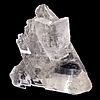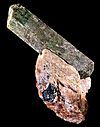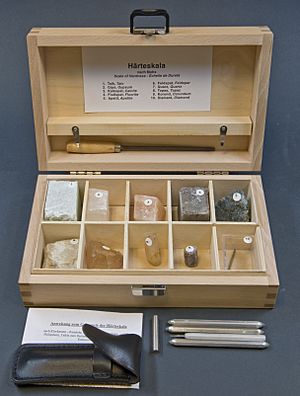Mohs scale of mineral hardness facts for kids
The Mohs scale (say it: MOHZ) is a way to measure how hard a mineral is. It helps us understand how easily one mineral can scratch another. The scale goes from 1 (very soft) to 10 (very hard).
A German scientist named Friedrich Mohs created this scale in 1812. He wrote about it in his book. People have been comparing how hard rocks are for a very long time, even thousands of years ago! The Mohs scale is great for identifying minerals when you are out in the field, like a geologist exploring.
Contents
What Minerals Are on the Mohs Scale?
The Mohs scale uses ten specific minerals as a guide. Each mineral has a different hardness level. If a mineral can scratch another, it means it is harder. If it gets scratched, it is softer.
Here are the minerals on the Mohs scale, from softest to hardest:
| Mohs hardness | Mineral | Image |
|---|---|---|
| 1 | Talc |  |
| 2 | Gypsum |  |
| 3 | Calcite |  |
| 4 | Fluorite |  |
| 5 | Apatite |  |
| 6 | Feldspar |  |
| 7 | Quartz |  |
| 8 | Topaz |  |
| 9 | Corundum |  |
| 10 | Diamond |  |
Sometimes, a material might have a hardness between two numbers on the scale. For example, your fingernail has a hardness of about 2.5. A copper penny is around 3.5. Glass is usually about 5.5.
It can be tricky to figure out the hardness of some materials. For example, granite is a rock made of several different minerals. Each of those minerals has its own hardness. So, granite doesn't have just one Mohs hardness number.
How Is the Mohs Scale Used?
The Mohs scale is very helpful in different jobs and industries.
For Geologists
Geologists use the Mohs scale to identify minerals in the field. They carry small kits with pieces of minerals or tools of known hardness. By trying to scratch an unknown mineral, they can figure out its hardness. This helps them know what kind of mineral it is.
In Manufacturing
The Mohs scale is also used in factories. For example, it helps decide what kind of machine is best for grinding down a certain material. If you know how hard something is, you can choose the right tools to work with it.
For Electronics
Companies that make electronics use the scale too. They test how strong and scratch-resistant things like phone screens or TV displays are. This helps them make sure your devices can handle everyday use without getting scratched easily.
See also
 In Spanish: Escalas de dureza para niños
In Spanish: Escalas de dureza para niños
- Brinell scale
- Geological Strength Index
- Hardnesses of the elements (data page)
- Knoop hardness test
- Meyer hardness test
- Pencil hardness
- Rockwell scale
- Rosiwal scale
- Scratch hardness
- Superhard material


